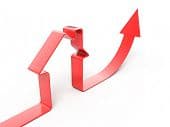Mortgage Tip: Where are Canadian Mortgage Rates Going in 2021

SUMMARY:
There is LOTS of room for rates to go up, and very little for rates to go down or even hold steady.
Fixed mortgage rates are predicted to rise by 40% and go back to Pre-Covid rates or higher:
- 2.9% (from 2.09% now) for less than 20% down; CMHC insured
- 3.10% (from 2.24% now) for more than 20% down; conventional / not insured.
Prime – what variable rates are based on:
- The Bank of Canada has moved their target for Prime increase from 2023 to 2022.
- The US Fed has moved their target for Prime increase from 2024 to 2023, and the market expects that to move to 2022 as well.
- Prime is 2.45% today, it was 3.95% just before Covid (Feb, 2020) and will be trending back that way soon.
- Prime – 1% is the rates for today. 2.45% – 1% = 1.45% which is a great rate but how soon and how much will it move?
This article is awesome, and clear on what the changes mean. The summary above is all you need but you love this data, then read on …
Canadian Mortgage Rates Forecast To Rise Over 40%, Posted Rate Can Hit 7%
Canadian inflation is marching higher, and so are the expectations for mortgage rates. One bank sees the 5-year posted rate having more room to rise than fall in the future.
The institution has forecast the posted 5-year fixed-rate mortgage can rise up to 40% by 2024.
While the posted rate is rarely the rate paid by mortgage borrowers, it does impact a number of things. More importantly, it reflects an environment where credit is tightening.
The Posted Mortgage Rate Vs What You Really Pay
The posted mortgage rate is an unusually high mortgage rate that’s kind of like the sticker price of a car. It’s unreasonably high, few people will use it, and it’s mostly to help buyers feel like they’re getting a deal. The spread between the posted rate and a lender’s best available rate is usually between 220 to 250 bps. This means the rate borrows often pay is a full 2.2 to 2.5 percentage points lower than the posted rate. That doesn’t mean the posted rate is useless though.
The two biggest impacts it has are on payment penalties and the stress test. If you were to break your fixed-rate mortgage early, for say refinancing at a lower rate, you have to pay a penalty. That penalty is usually 3-months of interest, or the interest rate differential (IRD). The IRD is the difference between your rate and the posted rate closest to your remaining term. Then subtract any discount you received at origination. It’s pretty much what banks use to make sure you pay a big ole’ penalty for changing plans.
The stress test rate is also likely to be influenced by the posted rate, but maybe not directly. Originally the Bank of Canada benchmark rate was used to determine the stress test rate. This was based on the posted rate at various banks. OSFI, the bank regulator, found it wasn’t very responsive to risk though. Rather than rely on the benchmark, they established a rate floor — the minimum rate that can be used. The criteria for how the floor can evolve can change a lot from now until 2024. However, it’s unlikely the stress test rate would ever fall below the posted rate. The stress test rate is currently around 50bps higher than the posted rate.
Canadian 5-Year Fixed-Rate Mortgages Have More Upside Risk Than Downside
There’s uncertainty, but Canada’s faster than expected recovery shows more upside than down. The five-year posted fixed rate is 4.74% currently. In a downside scenario, they see this falling to 4.40% by the fourth quarter of 2021. The upside scenario sees it rising up to 5.25% in the same quarter. Higher inflation expectations are also contributing to a stronger upside scenario.
Canadian Posted 5-Year Fixed Rate Forecast
By next year, the posted 5-year fixed rate is forecast for an even higher maximum — breaching the 6 point mark. Rates are forecast to have a downside of 4.6% in 2022, and an upside of 6.20%. In 2023, the range rises to 4.70% to 6.60% for the full year. In 2023, it gets a little more uncertain with the range widening from 4.55% to 6.95%. While the latter range is wider, it has a lot more upside than downside. The probability of it falling would likely require a substantial economic slowdown.
Since a number of factors go into a forecast, the longer the date, the more uncertainty it faces. Economic conditions would have to worsen and inflation drop for rates to fall. For rates to rise, Canada would have to continue a strong recovery, and/or see higher levels of inflation. Canada is so dependent on housing now, we likely have many people cheering on a crash to keep rates low.
Link to the full article is here: https://betterdwelling.com/canadian-mortgage-rates-forecast-to-rise-over-40-posted-rate-can-hit-7-desjardins/
